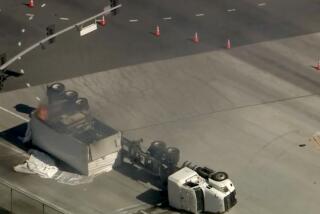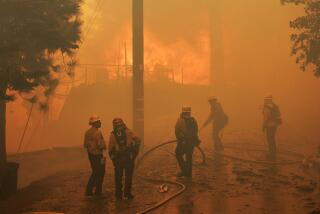Rehearsal for the Unthinkable at San Onofre
SAN ONOFRE — For the first time in seven years, Nuclear Regulatory Commission officials watched Wednesday as an emergency test was conducted at the San Onofre Nuclear Generating Station, located just three miles south of San Clemente and thousands of South County residents.
It was just a test, a simulated emergency that officials say is unlikely to occur. But for Harold Ray, a senior vice president with power plant owner Southern California Edison Co., it was an exercise in confronting the unthinkable.
Ray was huddled down, surrounded by nuclear engineers and technicians, trying to grasp the magnitude of the apocalyptic scenario before him: a major disaster at the San Onofre atomic plant that led to wide scale evacuations in Orange and San Diego counties.
During the drill, orders came to evacuate 35,000 people in San Clemente and thousands of others in San Juan Capistrano and Dana Point who live in a 10-mile radius around the plant in what is called a nuclear emergency zone. This zone also includes portions of Camp Pendleton and San Onofre State Park. Local agencies were asked to map out what it would take to get tens of thousands of people out of those areas.
The annual test was run from the San Onofre facility, located on a 257-acre site next to the Marine base and alongside Interstate 5. The San Onofre station is comprised of three nuclear units that at full power can produce enough electricity to meet the needs of nearly three million people.
The emergency scenario involved a complicated script devised by Edison and NRC officials, who monitor the responses of those involved and score them later in a detailed report. Participants, including Ray and 20 NRC employees, did not know what to expect and were forced to deal with a series of emergencies.
Lou Phelps, Edison’s vice president of corporate communications, said the script was designed to strip the plant of several built-in layers of defense mechanisms against disaster. It also condensed a period of several days into a six-hour period.
The mock countdown to disaster began with a coolant leak in one of San Onofre’s three reactors, followed by a fiery propane tanker truck collision on the San Diego Freeway just north of the plant.
Next, two television helicopters trying to film the truck accident collided in the air and crashed into the power plant’s electrical switchyard, causing a complete power loss to the plant and the surrounding area.
Then, there was a failure in a backup diesel-powered generator, which keeps the reactor’s cooling system running in a power failure, causing a release of radiation into the air. The final blow came when a crack appeared in the protective shell covering the reactor, allowing radioactive material to escape.
“We are practicing something that is highly unlikely to occur in the real world,” Phelps said. “The odds of all these things happening are incalculably small. But we (theoretically) have to do that to lose the ability to put water in the coolers, and in order for people in the cities to participate.”
Edison officials had no figures of how many casualties might occur under such a scenario.
Many Edison employees in the drill were matched with an NRC counterpart, said Russ Maribito, an NRC spokesman called in to assist from the agency’s Chicago offices. And all were watched by a handful of NRC observers.
Aside from handling technical problems and coordinating emergency responses, company officials also practiced relaying information to the media--a crucial element in trying to handle such a dire emergency.
Maribito said that getting accurate information to the public plays as important a role as stopping a radiation leak, a lesson officials learned during the Three Mile Island nuclear disaster. In that incident, considered the worst to date in the United States, radiation escaped from a malfunctioning nuclear reactor, and company officials were criticized for being too slow in getting accurate information out to the public.
“The whole emergency response scenario is an outgrowth of Three Mile Island,” Maribito said. “If there is a lesson to be learned, it is that you have to be prepared in the unlikely event of an emergency, and that includes notifying the pubic. Three Mile Island was a public affairs disaster.”
Ray said that a report detailing how the NRC scored the emergency response test would be available to the public in about 30 days and that company employees would be briefed on preliminary results by the end of the week.
During the drill, Ray and the plant’s emergency coordinator quietly reviewed information from nuclear engineers, radiation specialists and emergency response teams.
Around them, workers bustled in and out of cubicles, listening to two-way radios, keeping track of each move on a series of charts.
The response to the mock accident was played out in a “fishbowl,” a glass-partitioned office area in a radiation-proof building near the power plant. In a real emergency, this area would become the control center for Edison workers and NRC officials, Ray said.
“The hardest part is to keep in proper focus . . . to have an awareness of all the pieces of information necessary to make a decision,” said Ray, who is responsible for emergency decisions at the San Onofre plant.
Maribito, the NRC spokesman, said that Edison officials seemed to have handled the drill well but that if the NRC finds fault with their response, the federal government could suggest ways to improve Edison’s emergency program.
More to Read
Sign up for Essential California
The most important California stories and recommendations in your inbox every morning.
You may occasionally receive promotional content from the Los Angeles Times.










